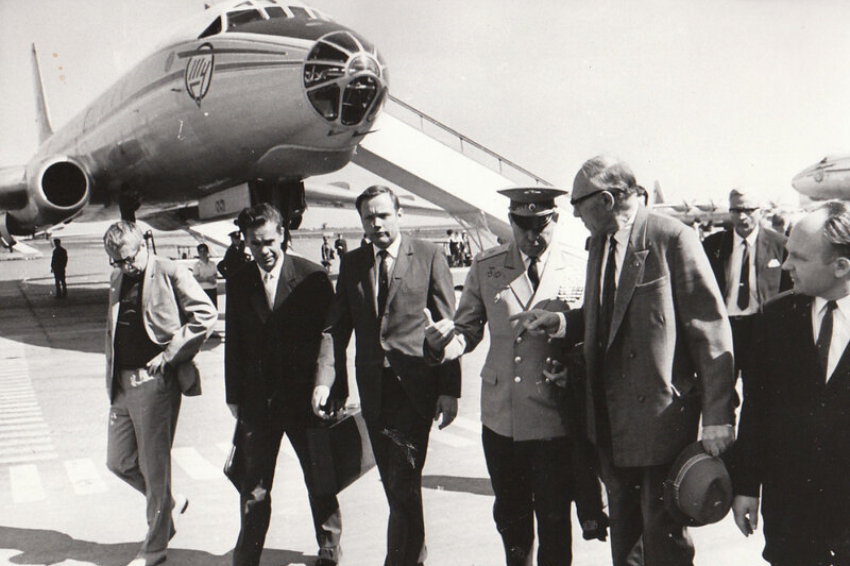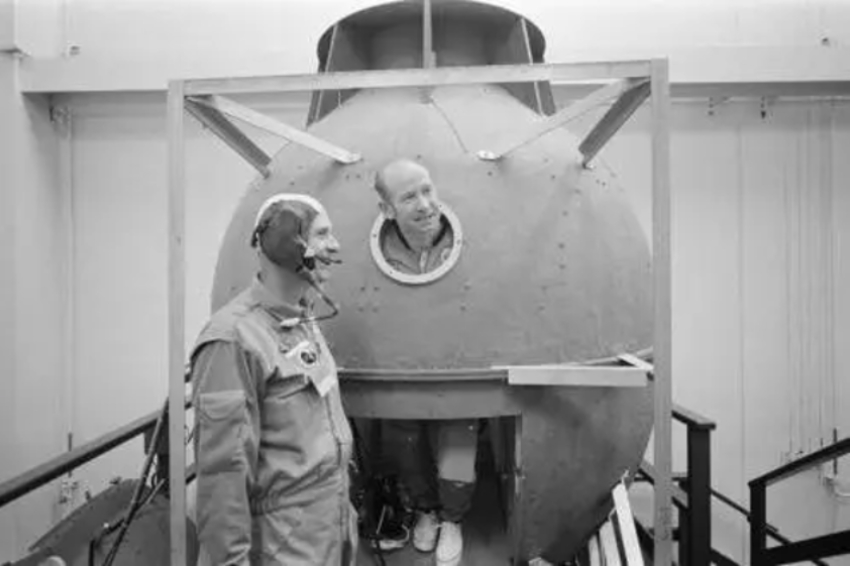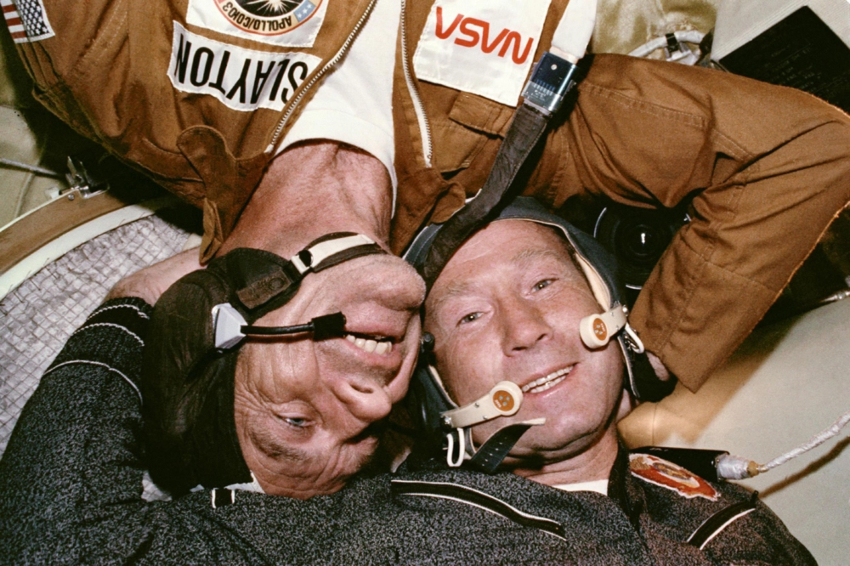Summer 1975. Despite progress in arms talks between the superpowers, the United States and the Soviet Union still have thousands of nuclear ballistic missiles aimed at each other. The United States is recovering from the Vietnam war, which ended with the fall of the South and communist control of the entire country. The Soviet Union is grappling with a deepening economic crisis. Civil wars are breaking out in Cambodia and Lebanon. Across the globe, a sense of instability prevails against the backdrop of the Cold War and its consequences. And yet, during this turbulent time, two spacecraft from these bitter adversaries meet in orbit. American astronauts speak Russian and shake hands with Soviet cosmonauts speaking English. For a brief moment, it seems possible to forget the wars and nuclear weapons below — to hope that this encounter in space is a sign that there is still hope for humanity.
The Historic Handshake in Space

Changing the Rules
The space race was one of the hottest fronts of the Cold War—not necessarily because of public interest in exploring the mysteries of the universe or the solar system, but more due to military implications. The ability to launch satellites, developed in the late 1950s, demonstrated the ability to use those rockets to deliver atomic bombs. The satellites themselves opened new opportunities for espionage and threats, and space was largely perceived as another battlefield.
In the early stages of the space race, the Soviet Union was the undisputed winner. It launched the first satellite in 1957, and that same year also sent the first living creature into orbit around Earth, before the United States managed to launch even a tiny satellite of its own. It sent the first human into space in 1961, and he orbited the Earth before the U.S. had succeeded in sending a man on a suborbital flight. The Russians also beat the Americans by sending the first woman into space; by launching a spacecraft with a crew, not just a single person; by performing the first spacewalk, and more.
And what do politicians do when their side is losing the race? They change the rules. Shortly after the Soviet Union won the race to put a human in space, U.S. President John F. Kennedy set an ambitious goal: to land a man on the Moon before the end of the 1960s. The Americans threw their full economic weight into this race, gradually closed the gap, overtook the Soviets, and in July 1969 fulfilled Kennedy’s vision (he had been assassinated in the meantime and did not live to see it realized) and landed humans on the Moon.
It was precisely after the American victory in the race to the Moon that a certain détente took hold on the political stage. Perhaps this was also because each superpower was now pursuing other objectives in space. The Americans continued the Apollo program, with six successful landings through the end of 1972, while the Soviets insisted that they had never planned to land on the Moon and turned their focus to space stations in Earth orbit. The thaw was also accompanied by a few reciprocal visits—American astronauts visiting the Soviet Union and Soviet cosmonauts visiting the U.S.—following meetings at neutral venues like the Paris Air Show. Less than a year after becoming the first human to walk on the Moon, Neil Armstrong made a goodwill visit to the Soviet Union in 1970. These meetings paved the way for contacts at higher diplomatic levels, and eventually led to the decision for a joint space mission.

A Bilingual Mission
In May 1972, U.S. President Richard Nixon and Soviet leader Alexei Kosygin signed a document for space cooperation for peaceful purposes. The document, signed at a conference in Moscow, also included a decision to develop a docking system that would allow an American spacecraft to dock with a Soviet spacecraft in space, which could be used, for example, in the event that a rescue was needed. As in other cases, here too the political agreement followed the work of practitioners. In the second half of 1971, American and Soviet teams met alternately in Moscow and Houston, reaching many agreements on the design of a two-sided docking adapter that would allow either spacecraft to be active or passive in the docking process.
The official signing of the cooperation agreement led, a few weeks later, to a general agreement on the joint mission, in which an American Apollo spacecraft and a Soviet Soyuz spacecraft would meet in space in 1975. But agreement on the docking adapter design was only the first step in addressing a long list of challenges. For example, Soyuz spacecraft maintained a cabin atmosphere of an oxygen-nitrogen mixture at 14 PSI, while Apollo used pure oxygen at only 5 PSI. Moving between the pressure differences and different gas compositions could have endangered crew health. The parties needed to decide how the rendezvous and docking would be carried out, in which spacecraft the crews would meet, what they would do together, and even—in which language they would speak.
In the end, they managed to overcome all the gaps: from deciding to lower the air pressure in the Soviet spacecraft, to selecting scientific experiments, and agreeing that each side would try to speak the other side’s language—that is, the Russians would speak English and the Americans would speak Russian.
In 1973, after the crews were officially selected, they began training for the mission. The astronauts, cosmonauts, and their backup crews trained alternately in the Soviet Union and the United States, in parallel with coordination between engineering teams, control teams, and other involved parties—and of course, with intensive language studies on both sides.
Not everything was smooth, of course. Both sides had considerable criticism of the other’s approach and practices. The Soviet approach favored spacecraft in which the crew should do as little as possible, with ground control able to operate the spacecraft if needed, while American spacecraft required far more work from the crews. The Americans also expressed concerns about the safety of the Soviet spacecraft, which had fewer backup systems than what was standard in American spacecraft. The Soviets, on the other hand, claimed that American spacecraft were too complicated to operate, making them dangerous. They also frequently accused the Americans of arrogance.
In the end, cooperation forced both sides out of their comfort zones. In the U.S., some expressed discontent with an equal partnership with the Soviets, fearing that it would lead to theft of American knowledge. The Soviets had to give up the secrecy that had characterized their space program and, for the first time, open their mission preparations to American crews—and also open up to the media and agree to live broadcasts of the launch, docking, and other mission elements.

Veterans and Rookies
The Apollo–Soyuz mission, known in English as the Apollo–Soyuz Test Project, or ASTP for short, was a kind of reward for the crew members. On the Soviet side were Alexei Leonov and Valery Kubasov. Leonov performed the first spacewalk in history in 1964 and later trained for a lunar flight on a mission that was canceled before it reached practical stages. Kubasov flew in 1969 on the Soyuz 6 mission, which suffered many technical difficulties. Both were assigned in 1971 to the Soyuz 11 mission and were supposed to be the first crew to staff a space station. But at the last minute, a suspicious finding appeared on Kubasov’s chest X-ray, and doctors—fearing tuberculosis—decided to replace the entire crew. That likely saved their lives, as the crew that launched instead perished during the return flight.
The Soviet crew for Apollo–Soyuz included only two cosmonauts, not three, due to modifications to the Soyuz spacecraft for this mission, including the decision that they would wear full space suits during parts of the mission because of concerns about loss of cabin pressure—for example, if docking failed.
On the American side, command was given to Tom Stafford, who had commanded Apollo 10—the dress rehearsal before the first human landing on the Moon. Stafford brought the lunar module to within 15 kilometers of the lunar surface but did not get to land. His two crewmates on that mission, John Young and Eugene Cernan, would later return to the Moon as commanders of the final Apollo missions and did land there.
He was joined by Donald (Deke) Slayton, who was one of the original seven astronauts selected for Project Mercury—the first U.S. human spaceflights. But before he had a chance to fly, doctors diagnosed him with an irregular heart rhythm and grounded him. He remained at NASA, was appointed head of the Astronaut Office, and for years assigned his colleagues and the next generations of astronauts to missions, while dreaming of flying himself. Only after many years did he succeed in stabilizing his heart condition and secured a seat on the Apollo–Soyuz mission at the age of 51—a venerable age for a spaceflight in those days.
The third American crew member was Vance Brand, selected as an astronaut in 1966, who had served on support and backup crews for Apollo missions and was slated to fly on Apollo 18, but that mission was canceled for budget reasons. Later he commanded two of the three backup crews for missions to the U.S. Skylab space station but did not get to fly. He waited nine years to fly in space before being assigned to Apollo–Soyuz.

Shaking Hands
On July 15, 1975, Soyuz 19 was launched from the Soviet space base in Kazakhstan. Less than eight hours later, the last Apollo spacecraft launched from Cape Canaveral in Florida. The two spacecraft moved along pre-determined orbits, with Apollo gradually closing the distance to Soyuz. On July 17, Apollo performed a maneuver that brought it into rendezvous orbit with the Soviet spacecraft. After a few minor trajectory corrections, Mission Control in Houston transmitted:
“We have two messages for you. Moscow confirms docking. Houston confirms docking. It’s in your hands. Enjoy!”
Stafford was responsible for manually steering the docking, and a few minutes after noon on the U.S. East Coast—early evening in Moscow—the long-awaited “click” was heard as the two spacecraft locked together 229 kilometers above the Atlantic Ocean.
“Apollo and Soyuz are shaking hands,” Leonov reported in English over the radio.
A little over three hours later, both crews completed preparations inside the connected spacecraft, including equalizing air pressure. Tom Stafford opened the hatch of the docking module and shook hands with Leonov—a moment broadcast live around the world. The crews exchanged gifts, signed commemorative certificates, listened to a greeting from Soviet leader Leonid Brezhnev read on Soviet television, and then spoke with U.S. President Gerald Ford, who called to congratulate them from the White House.
They later conducted several joint scientific experiments and even shared a meal. Neither spacecraft had enough room for all five crew members at once, so they periodically switched places and each spent at least a few hours aboard the other side’s spacecraft.
After about a day and a half, it was time to part. Each crew returned to its own spacecraft, and on July 19, shortly after 8 a.m. Eastern Time, the spacecraft undocked—but their joint work was not yet done. Apollo maneuvered away from Soyuz toward the Sun, creating an artificial solar eclipse that allowed the Soviets to photograph the Sun’s corona. A short time later, the spacecraft docked again, this time for practice purposes only, without crew transfers, and after about two and a half hours, they undocked for the final time. The Soviet spacecraft returned to Earth the next day, while the Americans remained in orbit for a few more days and landed on July 24.

Seeds of Cooperation
Despite the thaw in relations and the successful cooperation between the rival superpowers, the joint mission had no immediate continuation. Military tensions remained and even intensified during the 1980s, against the backdrop of U.S. President Ronald Reagan’s “Star Wars” program. The Soviets also feared that the advanced capabilities of the new U.S. Space Shuttle would be used for military purposes, prompting them to develop an almost identical shuttle of their own—but it flew only once, and unmanned.
Ultimately, it was the collapse of the Soviet Union that led to renewed cooperation. The two sides agreed to establish an International Space Station, and as preparation, Space Shuttles began visiting the Russian Mir space station. American astronauts stayed for extended periods on the Russian station, and Russian cosmonauts joined U.S. Space Shuttle missions.
The fact that these missions operated relatively smoothly—and that the International Space Station has been continuously crewed for nearly a quarter of a century, continuing to function well even during periods of political tension—is due in no small part to the spirit of cooperation that was sown at the height of the Cold War. This mission showed that cooperation in space was not only possible but beneficial to both sides.


